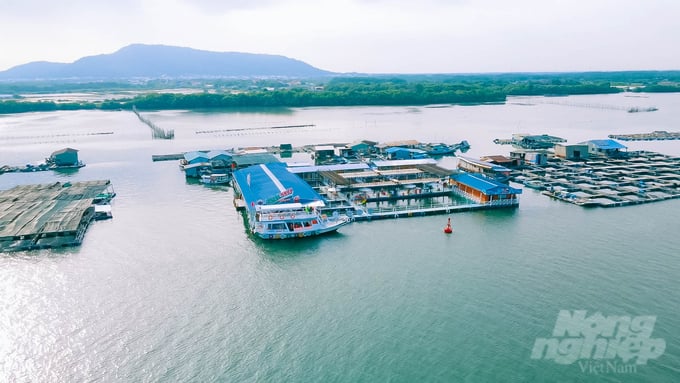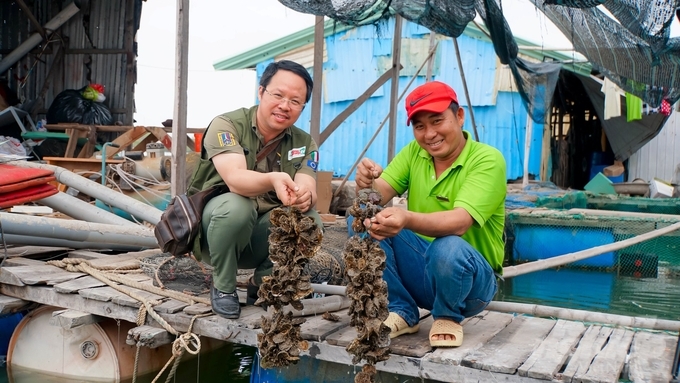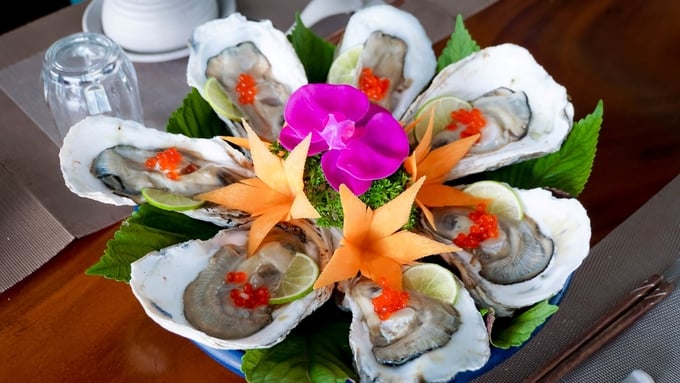June 19, 2025 | 15:44 GMT +7
June 19, 2025 | 15:44 GMT +7
Hotline: 0913.378.918
June 19, 2025 | 15:44 GMT +7
Hotline: 0913.378.918
For many years Long Son island commune (Ba Ria - Vung Tau) has been known as "the kingdom of oysters", not only abundant in quantity but also in type. The output of aquatic species in Long Son is about 15,000-20,000 tons per year, and most of which are oysters.
There are more than 300 farming facilities in Long Son with a total of over 13,500 cages. The water surface area reaches 3,000 ha full of aquatic products of high economic value. The location is near the sea, has a suitable salt concentration. Plankton frequently gathers in the area, which becomes a natural food source, rich in nutrients for oysters.

"The kingdom of oysters" Long Son is becoming a bright spot in the development of mariculture associated with ecotourism. Photo: Minh Sang.
Realizing oyster cage farming has far more potential than just the increase in productivity or the development of consumption link chains, at the end of 2022, Nhu Y Long Son Fisheries Cooperative was established. Although it has just been put into operation recently, the cooperative has proven the possibility of a link chain from farming to refining and packaging for export.
"We coordinate with travel agencies to bring tourists together after visiting Long Son, they will enjoy local oyster specialties. We are also promoting the packaging of oysters for domestic service. and export," said Mr. Nguyen Quy Trong Binh, Director of Nhu Y Long Son Cooperative.

With 13,500 cages used for raising oysters and other aquatic products, Nhu Y Long Son Cooperative yields 15,000 - 20,000 tons per year. Photo: Le Binh.
Coming to Nhu Y Long Son rafting village for the first time, Mr. Nguyen Quang Phuc's family, tourists from Ho Chi Minh City, were surprised and delighted after both going sightseeing and enjoying fresh specialties. Many times before, Mr. Phuc only went to Vung Tau to swim, enjoy seafood and then return to Ho Chi Minh City, but have not experienced this new form of ecotourism.
"Very few have the opportunity to learn about the growth of oysters and fish species in cages in a natural river like this. Our family can now know more about the aquaculture village and see the interesting fishery activities up close,” Mr. Phuc said.
To Ms. Pham Thi Na, Deputy Director of Ba Ria - Vung Tau Department of Agriculture and Rural Development, this new form of integrating oyster farming and tourism is one of the key models of the province. The department is conducting further studies on the model and replicating it in the area. "Tourism and mariculture are two economic pillars of Ba Ria - Vung Tau. The model that Nhu Y Long Son Cooperative presents converges both of these things. This is a new path, not only for the province's tourism industry but also a point model of the province's agricultural sector”.
After the Covid-19 pandemic, tourism associated with nature and rural areas becomes more of a common trend. For Ba Ria - Vung Tau in particular, this is an advantage to seek benefits from rural areas, agriculture and tourism development.
Some mariculture - tourism models have been put into operation fairly well with clean and quality agricultural products, after that comes the forming of a self-contained experience tour. Thanks to that, farmers not only increase their income but also creates a new wind to attract tourists.

Long Son oysters are also aimed to "go abroad", serving the dietary needs of countries around the world. Photo: Le Binh.
According to Mr. Tran Cong Khoi (Department of Fisheries), the orientation of mariculture combined with tourism in Ba Ria - Vung Tau is suitable for the new situation. The advantage of this orientation lies in the fact that ít uses mariculture to raise tourism and takes tourism to raise mariculture. But Mr. Khoi believes that there need to be synchronized, methodical actions for the model to go in the right direction.
Firstly, the promulgated planning must be synchronized between fisheries, agriculture, tourism and other industries. If it is in favor of a certain industry, it would be very dangerous for other industries and development will be unbalanced.
Secondly, seafood produced in Ba Ria - Vung Tau must be safe. Its quality should be regularly monitored and traceability is assured, especially in environmental observation and disease surveillance.
Thirdly, trade promotion is needed. Currently, other provinces have also done well in this regard, so there is no reason for Ba Ria - Vung Tau not to promote fisheries product trade. It can be fairs, exhibitions, or food exchanges.
Translated by Samuel Pham
![Turning wind and rain into action: [9] Digitizing hydrometeorological data in response to climate change](https://t.ex-cdn.com/nongnghiepmoitruong.vn/608w/files/news/2025/06/17/z6704423696987_15fd32ffc26d590d204d520c9dac6786-nongnghiep-165943.jpg)
(VAN) Farmers have begun accessing hydrometeorological applications to adjust their cropping schedules, aiming to ensure productivity and adapt to climate change.
![Turning wind and rain into action: [8] Real-time salinity detection and early warning technology](https://t.ex-cdn.com/nongnghiepmoitruong.vn/608w/files/news/2025/06/17/z6704423696987_15fd32ffc26d590d204d520c9dac6786-nongnghiep-151127.jpg)
(VAN) Thanks to the integration of modern hydrological-hydraulic models, remote sensing technologies, and artificial intelligence, the accuracy of hydrological forecasting has significantly improved.
![Turning wind and rain into action: [7] Early disaster warnings help marine farmers minimize losses](https://t.ex-cdn.com/nongnghiepmoitruong.vn/608w/files/news/2025/06/17/z6704423696987_15fd32ffc26d590d204d520c9dac6786-nongnghiep-142942.jpg)
(VAN) In recent years, thanks to early disaster warnings and forecasting, marine farmers in Khanh Hoa province have been able to reduce risks and losses, thereby improving production efficiency.
![Turning wind and rain into action: [6] ‘Four on-the-spot’ disaster management software](https://t.ex-cdn.com/nongnghiepmoitruong.vn/608w/files/news/2025/06/17/e5a48259d6a262fc3bb3-nongnghiep-183800.jpg)
(VAN) By simply activating the scenario on the disaster management software, the relevant authorities immediately know how many households need to be evacuated, where to evacuate them to, and by what means of transportation…
![Turning wind and rain into action: [5] Hue applies modern technology in disaster forecasting](https://t.ex-cdn.com/nongnghiepmoitruong.vn/608w/files/news/2025/06/17/z6704423696987_15fd32ffc26d590d204d520c9dac6786-nongnghiep-093938.jpg)
(VAN) In Hue city, modern technology has recently been applied in meteorological and hydrological forecasting and warning, helping to reduce the damage caused by natural disasters.

(VAN) A cutting-edge farming technique being implemented on an experimental ranch in Arizona's Sonoran Desert has already saved a billion gallons of water over five years, according to Civil Eats.

(VAN) Poultry and pig production and the environment can be boosted through enhanced water technology, according to new research.